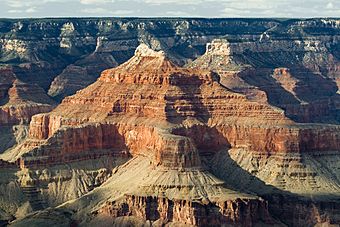Esplanade Sandstone facts for kids
Quick facts for kids Esplanade SandstoneStratigraphic range: Lower Permian, 290–287Ma |
|
|---|---|

south view of Isis Temple, Grand Canyon, from 2-mi, on Tonto Trail, Tonto Platform
uppermost vertical red cliff of Esplanade Sandstone (the lower large red vertical cliff is Redwall Limestone upon a lower shelf-cliff of grayish vertical Muav Limestone) |
|
| Type | Geological formation |
| Underlies | Hermit Formation-(Permian), Grand Canyon; (Hermit elsewhere in Arizona: (west)-Oak Creek Canyon region, Sedona, AZ (townsite)) |
| Overlies | Wescogame Formation, (3rd member)-Supai Group |
| Thickness | 330 feet (100 m) approximate maximum |
| Lithology | |
| Primary | sandstone |
| Location | |
| Region | (southwest) Colorado Plateau Northern Arizona, Grand Canyon, basement rocks of Verde Valley, Arizona, & extreme southwest Utah |
| Extent | Grand Canyon |
The Esplanade Sandstone is a special type of rock found in the Grand Canyon. It's a dark red sandstone that forms tall cliffs. This rock layer is from the early Permian period, which was about 290 to 287 million years ago.
You can see the Esplanade Sandstone forming a strong, flat shelf in the western part of the Grand Canyon. This shelf, called The Esplanade, is about 20 miles (32 km) long. It's a popular spot for trails and exploring the amazing canyon landscape.
Contents
What is the Esplanade Sandstone?
The Esplanade Sandstone is a type of geologic unit. This means it's a distinct layer of rock that geologists study. It's known for being very strong and resistant to erosion. This is why it forms cliffs and flat areas.
The rock is mostly made of sandstone, which is rock formed from sand grains. Its deep red color comes from minerals like iron.
Where to Find Esplanade Sandstone
The Esplanade Sandstone is mainly found in Arizona. You can see it in the Grand Canyon and nearby areas like the Verde Valley. It's also part of the larger Colorado Plateau region.
One famous spot to see it is near Toroweap Overlook. Here, the sandstone creates a tough layer that stands out. The Esplanade Route trail in the eastern Grand Canyon is even named after this rock layer.
Esplanade Sandstone in the Grand Canyon
The Esplanade Sandstone is part of a larger group of rocks called the Supai Group. This group is famous for its "redbeds," which are layers of reddish rock.
Let's look at the layers of rock you might see at a place like Isis Temple in the Grand Canyon:
- Coconino Sandstone: This is a white rock layer at the very top.
- Hermit Formation: Below the Coconino, you'll find grayish slopes.
- Supai Group: This is a thick section of reddish, sloped rocks. The Esplanade Sandstone is the top part of this group.
- Esplanade Sandstone (forms cliffs)
- Wescogame Formation
- Manakacha Formation
- Watahomigi Formation
- Redwall Limestone: A large, vertical red cliff below the Supai Group.
- Muav Limestone: A grayish cliff attached to the bottom of the Redwall.
- Bright Angel Shale: A light greenish slope.
- Shinumo Quartzite: Dark brown, massive cliffs at the very bottom.
How the Esplanade Sandstone Formed
The rocks of the Supai Group, including the Esplanade Sandstone, formed a long time ago. They were created when ancient oceans moved across the land. This is called marine transgression (when the sea level rises and covers land) and regression (when the sea level falls).
Because the ocean levels changed, different types of material were laid down. This created layers of sandstone, siltstone, and other rocks. Sometimes, the land itself would rise or sink, also affecting how these layers formed.
The sand and mud that became these rocks came from two main directions. Some came from ancient mountains to the west, like the Antler Mountains. Other material came from the east, from the main continent. All these sediments settled in ancient basins, which are like large dips in the land.
Similar Rocks in Other Places
While the Esplanade Sandstone is unique to Arizona, other rock groups formed at the same time in nearby areas. These are called "coeval" units, meaning they are of the same age.
For example, in Utah and parts of Colorado, a similar group of rocks is called the Hermosa Group. The Cedar Mesa Sandstone in eastern Utah is considered to be the same age as the Esplanade Sandstone. Even though they are in different places, they tell us about the same time period in Earth's history.

